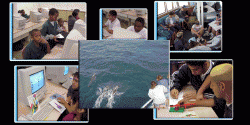What are WebQuests?
WebQuests were created by Bernie Dodge and Tom March in 1995 at San Diego State University. “A WebQuest is an inquiry-oriented activity in which most or all of the information used by learners is drawn from the Web” (Dodge and March). Therefore, WebQuests are an inquiry and project-based asynchronous online learning tool designed for use by K-12 students.
WebQuests are a structured lesson tool and usually have six parts:
Typical project themes might deal with:
Collaboration is usually an improtant part of a WebQuest. Finally, WebQuests are generally public and the company provides a search facility to find topics of interest. WebQuests show that a structured and orderly educational object can be created from a useful, well-researched template on top of the unstructured Internet.
Short-term WebQuests typically take 1-3 days, but a WebQuest can take longer.
WebQuests are a structured lesson tool and usually have six parts:
- introduction
- task
- process
- resources
- evaluation
- conclusion
Typical project themes might deal with:
- bringing contemporary world problems into the classroom
- evaluating history
- creating products
- dealing with life's realities
- and sparking students' learning
- or any other theme the teacher can think of.
Collaboration is usually an improtant part of a WebQuest. Finally, WebQuests are generally public and the company provides a search facility to find topics of interest. WebQuests show that a structured and orderly educational object can be created from a useful, well-researched template on top of the unstructured Internet.
Short-term WebQuests typically take 1-3 days, but a WebQuest can take longer.
See the video below for more information!

